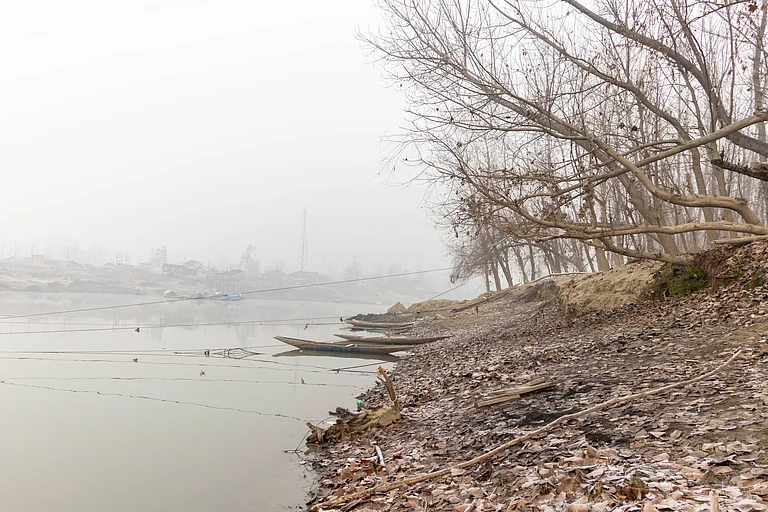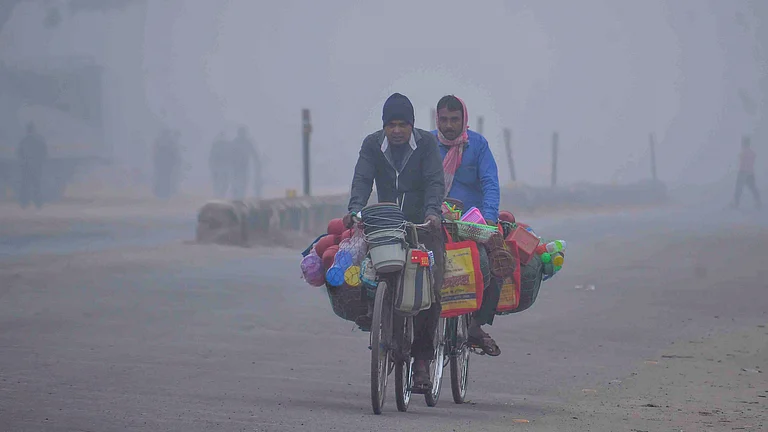The slogan of Rajasthan Tourism says "Jaane Kya Dikh Jaye (Who knows what will be seen)". It comes to life as we pass through a village called Rotoo in the Nagaur district of Northern Rajasthan in the scorching afternoon sun of April. The 33-year-old Ratna, carrying her 11-month-old son in her lap and drawing water from a tank with a bucket about 300 meters away from her house. Ratna says, “I need this water to get my house whitewashed, as guests are coming to my place next week. My father-in-law paid a sum of Rs. 1500 to a water vendor named Bhikaram, who used his water tanker to fetch us water from the neighbouring village.”
The barren deserts of the Northern Rajasthan have long faced severe water shortages, but the situation has turned critical in the last few years. The inconsistent monsoons and climate change have converged to create a unprecedented water crisis in this region.
In a neighbouring village, Kashipura, six middle-aged men sit sadly near a small pond, which is covered with green algae. Five water tankers are parked a few feet away from them. One of the six men is Shri Kisan Bishnoi, says “We have been sitting here since 5 in the morning, it is already 3:30 and we are still waiting for water. Sometimes water is released from the Indira Gandhi Canal which reaches here through pipes. The last time we got water was 5 days ago. We don’t have a single drop of water left at our home.”

There is an old water reservoir in Kashipura which was built for rainwater harvesting. Residents say that earlier when the reservoir used to have water, a village elder would always guard it so no one would use the water for washing clothes or cleaning etc. But this reservoir has remained dry for the last 3 years.
“Ours is a drought-affected village. It is not that we do not have water here, we have a few tube wells that provide some water, but we cannot drink that. That water is full of salt. Many people who cannot afford tanker water, drink salty water. About ten years ago, the population of our village was around 3000, now only a few hundred people are left, most of them are old people. Many people from our villages moved to Jaipur or Ahmedabad, where they are getting both jobs and clean water.” Shri Kisan adds.
This dry area of Rajasthan is called the Shekhawati region. For the last 30 years, the state and union government have been planning to build a canal (locally known as the Shekhawati Canal) through which clean water from the Yamuna river can be provided to this area.
Ram Singh, 87, a resident of Danta village in Sikar, is known as Kakaji by people. Kakaji runs a tea stall in the village. He says, “More than half of my monthly income is spent on buying clean water. People are scared to get their daughters married in this village. Over the years, different politicians have come here and promised to bring water to this area, but no one has returned after the elections. Now the situation is such that no one even talks about the water problem.”
The water crisis has taken a heavy toll on agriculture which used to be the backbone of the local economy. Due to the situation of water scarcity, farmers are abandoning cultivation to join other works.
Amra Ram, a farmer leader, member of the CPI(M), and candidate from Sikar constituency from INDIA bloc for the general elections 2024. The region has seen many farmers’ agitations under his leadership. Asked about the water problem in this area, he replied that if their government is formed, they will make a policy for the water problem as soon as possible. “I am a farmer myself and I know that the issue of water is the biggest problem here.”

Water scarcity is not the only crisis plaguing the regions, another insidious has emerged - the pervasive contamination of groundwater by excessive fluoride levels.
“Log athe umar su pehle budda ho jave” (people here grow old before their age), said, the 82 years old Kanha Singh ‘Fauji’. He is a retired soldier and resident of Jalabsar village of Bikaner. In Jalabsar and the neighbouring villages, the crisis of contamination of ground-water with high fluoride levels has emerged as a threat. Residents, particularly the elders and children, often evince bowed legs and stiffened joints, leaving them in constant pain and limited mobility.
“Earlier it was not like this, the water of this area was drinkable. The situation here has deteriorated in the last few years. Many people in our village can’t run as soon as they reach the age of 35-40. Their teeth start falling and they start having unbearable pain in their knees. We’ve raised our concern with many political leaders but no one made any effort to solve our problems.” Kanha Singh adds.
The contamination causes not only skeletal fluorosis but also dental fluorosis. Due to drinking fluoride-contaminated water, people of all ages in this and surrounding villages have been found to have weak and discoloured teeth.
Purkha Singh, another resident of the village, says, “Clean water is a luxury for us, during the rainy season we save some rainwater in our tanks and only offer it to our guests. For us, rainwater is way more important than ghee. If there is any function in our house then we have to get water from distant villages through water tankers. The price depends on the taste of the water and from how far it comes. We generally get water from a neighbouring village called Surjansar, a tank of water costs us about Rs. 1200.”
He adds, “The water we drink looks clean but if you pour it on the sand, after some time, a white layer of salt will form on that sand. Even our utensils and earthen pots are affected by this water. It is working as a slow poison for us.”
According to research conducted by the USA Government’s National Library of Medicine, “In Rajasthan, around 40 lakh people are affected with fluorosis, which is the highest in the country.”




























